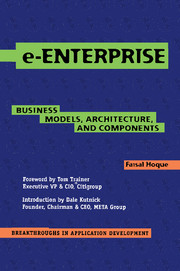Book contents
- Frontmatter
- About the Author
- Contents
- Dedication
- Foreword
- Acknowledgments
- Introduction
- PART 1 The e-Enterprise
- PART 2 Business and Application Models
- Chapter 2 e-Application Models
- Chapter 3 B-to-C e-Application Models
- Chapter 4 B-to-B e-Application Models
- PART 3 e-Enterprise Methodology and Architecture
- PART 4 Enabling Components
- Afterword: Who Will Be the Great e-Enterprises?
- References
- Index
Chapter 2 - e-Application Models
Published online by Cambridge University Press: 20 May 2010
- Frontmatter
- About the Author
- Contents
- Dedication
- Foreword
- Acknowledgments
- Introduction
- PART 1 The e-Enterprise
- PART 2 Business and Application Models
- Chapter 2 e-Application Models
- Chapter 3 B-to-C e-Application Models
- Chapter 4 B-to-B e-Application Models
- PART 3 e-Enterprise Methodology and Architecture
- PART 4 Enabling Components
- Afterword: Who Will Be the Great e-Enterprises?
- References
- Index
Summary
NET FOR BUSINESS?
Not only has the basis of computing changed, the basis of competition has changed too.
—Andrew S. Grove, Chairman, IntelLet's start out by taking a moment to ask—and answer—the most obvious of “e” questions: why do companies that are already successful at selling their products via the more traditional distribution channels (retail locations, catalogs, television, and even the telephone) feel the need to sell their wares online? In short, what is the appeal of the Net?
First and foremost, the Net enables businesses to interact personally and directly with customers without incurring the overhead costs of building a larger sales force, opening new retail locations, or hiring and training new customer service representatives.
At first glance, this seems a bit absurd. How does the World Wide Web—largely just a repository of text and images—increase personal interaction? The answer lies in the capability of computers to gather, store, and transmit mountains of data in the blink of an eye. By always utilizing this information in real time, enterprises can focus on building personalized, long-term relationships with each and every customer, such as was done before the days of strip malls, superstores, and direct-mail catalogs. In many ways, this is a better way to do business. Let's pick a simple example to illustrate.
Say you want to read A Tale of Two Cities. Today, you'd probably just head down to the local branch of a national bookselling chain and buy a copy.
- Type
- Chapter
- Information
- e-EnterpriseBusiness Models, Architecture, and Components, pp. 23 - 56Publisher: Cambridge University PressPrint publication year: 2000



